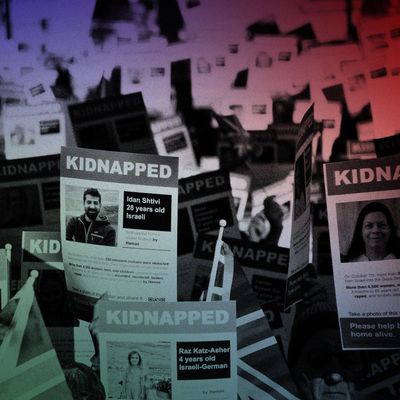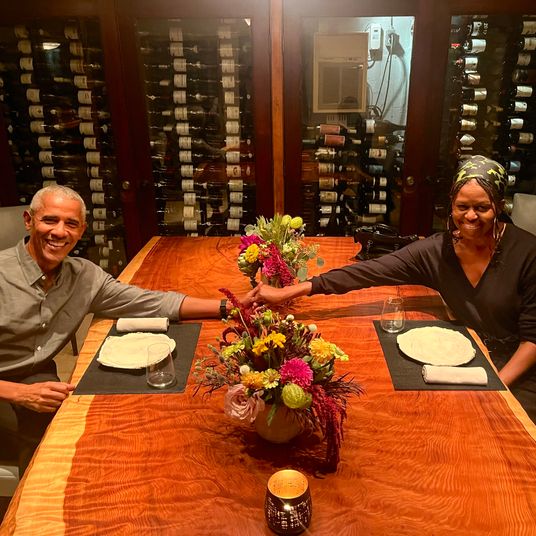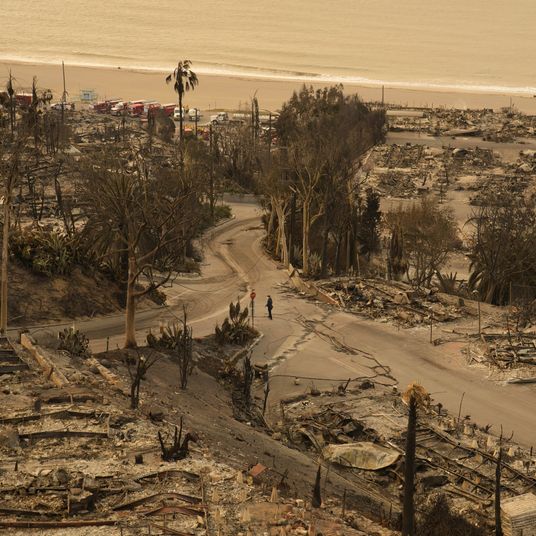
After six weeks of a catastrophic war, fighting between Israel and Hamas is expected to cease for four days on Friday. The two sides have agreed to a breakthrough deal that would send 50 women and children held hostage by Hamas to Israel, in exchange for the country freeing at least 150 Palestinian women and children from Israeli jails. But the agreement brokered between Qatar, the United States, and Egypt is only a start, with the war expected to resume after that pause and nearly 200 more people remaining captive in Gaza.
Why did Israel and Hamas agree to this deal, and what does it mean for the war? I spoke with Gershon Baskin, an Israeli peace activist who played a key role in the freeing of Gilad Shalit, the Israeli soldier who was kidnapped by Hamas in 2006 and freed five years later in exchange for hundreds of Palestinian prisoners. Baskin was recently profiled in the New York Times, which documented his erstwhile friendship with a member of Hamas.
Negotiations between Israel and Hamas have been going on for several weeks, even before Israel’s ground invasion began. Why do you think a breakthrough happened at this moment?
These things take time before they’re ripe. That’s simply the reality of the situation.
On day three of the war, I contacted people in the War Cabinet in Israel indirectly through two heads of former security establishments there. I contacted people in Hamas, in Gaza, in Beirut, and in Doha. I contacted Mohammed Al-Emadi, the Qatari emissary who was going back and forth between Gaza and Israel. He talked to Egyptian intelligence and told them that for a deal that would release all the women, the children, and the elderly, they could get in return, from Israel, 43 women prisoners and 190 minors under the age of 18. That sounded to me like a deal, and I started pushing it through. I got signals from people inside the Israeli War Cabinet — two ministers, in fact — who said if a deal like that was on the table, they would support it.
It didn’t happen. But this proposal for women and children in a broader sense was out there from the very beginning, and it just took time before they were ready to make the deal. Part of it could be what the Israelis claim — which I don’t really buy into — was the military pressure on Hamas that made them make the deal. I don’t agree with that because from what I know, two weeks ago the Egyptians were about to receive a list from Hamas of the women and children they were ready to release, and they froze the process when Israel surrounded Gaza City and started penetrating inside the city.
For Hamas, do you think the most attractive part of this agreement is the cease-fire or the prisoner release?
I think Hamas’s ultimate goal — Yahya Sinwar’s goal — is to free all the prisoners in Israel, but I think what was most important to them was the cease-fire. Their point of view was dependent on getting the Israeli agreement not to fly drones over the skies of Gaza while they are releasing hostages, and they got that.
I think they need the cease-fire because they need to reorganize, regroup, rearm, re–figure out their plans for the next stage of the war. I think it’s probably in the back of their minds that if the cease-fire can be extended, there’ll be international pressure on Israel to end the war where they are. And then Hamas comes out victorious.
Of course, Israel wouldn’t do that. It’s a dead letter.
There is no scenario where this war ends with Hamas in control of Gaza.
On the Israeli side, I’ve heard people theorize that Netanyahu agreed to this in part because of all the domestic pressure on him, especially from families of hostages who have organized politically.
It could very well be. But five days ago, apparently, the same offer was on the table, maybe with a few little differences — President Biden helped get some concessions from the Hamas side — not really significant ones.
You told my colleague when you spoke to him a few weeks ago that Qatar was dealing mainly with the political leadership of Hamas in Doha and not in Gaza, so you were skeptical that they could broker a deal with the right people. But obviously, they did succeed.
They didn’t do it alone. They did it together with the Egyptians. The Egyptians are not getting enough credit. The person of consequence in the Hamas leadership who’s in Doha now is Sinwar’s deputy, Khalil al-Hayya, who, for obvious reasons, left Gaza before the war and ended up in Qatar. When Hamas leader Ismail Haniyeh and former leader Khaled Mashal flew to Egypt to meet with the head of Egyptian intelligence, Khalil al-Hayya was with them.
He’s one of the most extreme people in Hamas that I know of. I believe the reason he was present in Egypt and went to Doha before the war was to be that channel of communication with Sinwar. I think the communication with Sinwar in Gaza is through Egyptian intelligence and not directly from Qatar. I don’t see how they can communicate without being disclosed to the Israelis. There’s no digital communication being used.
Are they even communicating directly with people in Gaza?
I’m sure they are. One reason the deal took so long is because communication is so convoluted. I’m sure Khalil al-Hayya has people in Gaza he communicates with who then send messages one-to-one, passing messages back and forth.
Do you think there could be more of these kinds of deals in the near or distant future?
Maybe. The best way to do it, as Israel has said, is that if it goes well and according to plan, there could be a day five, six, seven, eight, nine, ten of the cease-fire until all the women and children are released. I think from Hamas’ point of view, they want to extend the cease-fire, and holding on to these women and children and probably sick people is a burden. What they’re interested in is the soldiers, and the soldiers are enough for them to make them believe they can negotiate a deal to release all the Palestinian prisoners in Israel.
Is there a scenario where that happens, where all Palestinian prisoners in Israel are freed?
No, I don’t think so.
Because they’re too dangerous?
We’re talking 7,200 prisoners; 559 of them are serving life sentences for murdering Israelis, many of them multiple life sentences — plus there are 130 of the terrorists who were caught in Israel on October 7, plus another 300 Hamas fighters who have been taken out of Gaza into Israeli custody. We’re talking about a group of people I can’t see Israeli society or the current Israeli government ever agreeing to release. That basically means those people who are classified by Hamas as soldiers are going to be held for as long as they can hold them, and the Israelis will probably have to use special forces to rescue them.
The deal you were so intimately involved with, the one to free Shalit back in 2011, involved swapping more than 1,000 Palestinian prisoners for one guy. I don’t know what they were all accused of, but one of them was Sinwar, who is considered the mastermind of the October 7 attack.
Not only that: In the first group that was released, which is 450 people plus 27 women, based on a list from Hamas, there were more than 300 people who had killed Israelis.
Is there any second-guessing on your end about that deal given recent events?
Look, at the time, Netanyahu supported it, and 26 members of his government voted for it. Only three ministers voted against it. The head of the Shin Bet, the head of the Mossad, the chief of police, and the commander-in-chief of the army all recommended that the government support it. There were things built into the agreement to mitigate risks to Israel. Primarily, 25 people who were identified as the most serious terrorists were deported from here forever. They were scattered around different places in the world.
Of the prisoners from the West Bank, 50 percent minus one were sent to Gaza because the Israelis believed that in Gaza they would have less of a chance of hurting Israelis. That turned out to be a mistake because most of the prisoners who were sent to the West Bank actually entered into normal life. Some of them didn’t, but they were rearrested by Israel and because they were in the West Bank, Israel could rearrest them easily.
Sinwar was thought to be a danger. I don’t think he was perceived to be as much of a danger as he turned out to be. There was actually thinking that, having known Israel so well and being fluent in Hebrew, he could actually turn out to be pragmatic.
Yeah, obviously a miscalculation.
There’s a very good book published by a guy named Tareq Baconi, a Palestinian who did deep research on Hamas, and the whole theory of his book is that the weight of governance on Hamas was making it more pragmatic — not more moderate but more pragmatic. And that was certainly my thinking as well. I began to be suspicious when I kept proposing to my interlocutor that we figure out how to do a long-term cease-fire, as we had started to negotiate back in 2012, and there was resistance to doing that. I should have been more aware that the resistance was actually because they were planning a major attack.
In the summer of 2021, I was trying to get him to meet me for a few days in Norway. That didn’t work out in the end. And then when I tried to push him for us to meet in Cairo a month before the war, he told me, “I can’t.” And that was the first time he ever said “I can’t” to me. He said he would ask for permission, he would talk to Sinwar, and then the month before the war, he said he couldn’t meet me.
I read the New York Times article about your relationship with him. I assume you haven’t spoken to him since that came out.
No. Even after the letter I wrote to him, I sent him a few messages — because if it can save lives, then I would talk to anyone, even him. But he didn’t open them up, and he didn’t respond.
Does this deal make you hopeful in any way about the arc of this conflict, beyond just being happy that some prisoners are being released?
First of all, every hostage that returns is a reason to celebrate and be happy, and Israel needs to get every single one out as fast as possible. One more word about the negotiations: This is a very bizarre negotiation for two reasons. It’s really a negotiation of one side. Hamas makes the proposal, and Israel either says “yes” or “no.” There’s no real back-and-forth between Israel and Hamas, and they’re certainly not talking directly. The second thing that’s really bizarre is that Israel is negotiating with people they intend on killing. I don’t know of another situation like this where you’re negotiating with someone you’re intending to kill in a very short time.
It’s similar to cease-fire negotiations in any conflict, though, right?
It’s not always the stated goal of a war operation that our goal is to kill the leaders of the other side. It’s very clear this is what Israel’s intention is. And I’ve said a few times in Israeli media — they asked me what could go wrong — let’s say that tomorrow the Israelis discover where Sinwar is hiding. Are they going to take the shot, or are they not going to take the shot? It’s a onetime opportunity. Of course, they’re going to take the shot.
And that would completely scuttle the deal and any future deals.
Exactly. But they would not miss the opportunity to take him out.
And there are other things that could foil the deal. But it’s a good deal; it’s a cheap deal for Israel in terms of the price Israel is demanded to pay. There are risks involved, of course, because they have to redeploy the forces so they’re not sitting ducks. And there are a million things that could go wrong. But if it goes forward for four days and it works, and Hamas agrees to send another ten hostages, then there’ll be another day of cease-fire and maybe another day of cease-fire. With all the women and children they have, and if they include the elderly as well, there could be a ten-day cease-fire without another negotiation. That’s a possibility. Another possibility is that there could be another negotiation to release the other people — but not the soldiers.
This interview has been edited for length and clarity.






























